
sqlite 提供了一種 redo log 型事務實現,支持讀寫的并發,見 write-ahead log(https://sqlite.org/wal.html)。
一. wal 原理
1.1 redo log
sqlite wal 是一種簡單的 redo log 事務實現,redo log 概念這里簡述下。數據庫事務需要滿足滿足 acid,其中原子性(a),即一次事務內的多個修改,要么全部提交成功要么全部提交失敗,不存在部分提交到 db 的情況。
redo log 的解決思路是將修改后的日志按序先寫入 log 文件(wal 文件),每個完成的事務會添加
checksum,可鑒別事務的完整性。事務寫入日志文件后,即代表提交成功,讀取時日志和 db 文件合并的結果構成了 db 的完整內容。同時定期
checkpoint,同步 wal 中的事務到 db 文件,使 wal 文件保持在合理的大小。日志文件持久化到磁盤后,已提交成功的事務按序
checkpoint 執行的結果都是一樣的,不受 crash 和掉電的影響。
sqlite 的 wal 也是這種思路的實現,只是 sqlite 提供的是一種簡化實現,同時只允許一個寫者操作日志文件,日志也是 page 這種物理日志。redo log 還能將 undo log 的隨機寫轉化為順序寫,具有更高的寫入性能,這里不贅述。
想對 redo log 進一步了解,可以參考以下資料:
??https://zhuanlan.zhihu.com/p/35574452??
??https://developer.aliyun.com/article/1009683??
1.2 sqlite wal
sqlite wal 寫操作不直接寫入 db 主文件,而是寫到“db-wal”文件(以下簡稱'wal'文件)的末尾。讀操作時,將結合 db 主文件以及 wal 的內容返回結果。wal 模式同時具有簡單的 mvvc 實現,支持文件級別的讀寫并發,提供了相對 delete(rollback) 模式 (undo log 事務) 更高的并發性。 具體可看圖加深理解。
下圖中:
- pgx.y,x 表示當前 page 的 num,y 表示當前 page 的版本,每個提交的事務都保存當前修改后的 page 副本;
- 圖中 wal 中提交了兩個事務,wal 中藍色框表示一個完整事務修改的所有 page;
- wal 實際中保存的單位是 wal frame,除了修改的頁面還會保存 page number checksum 等信息,這里為了突出展示了 page, 詳細格式見:https://www.sqlite.org/fileformat2.html
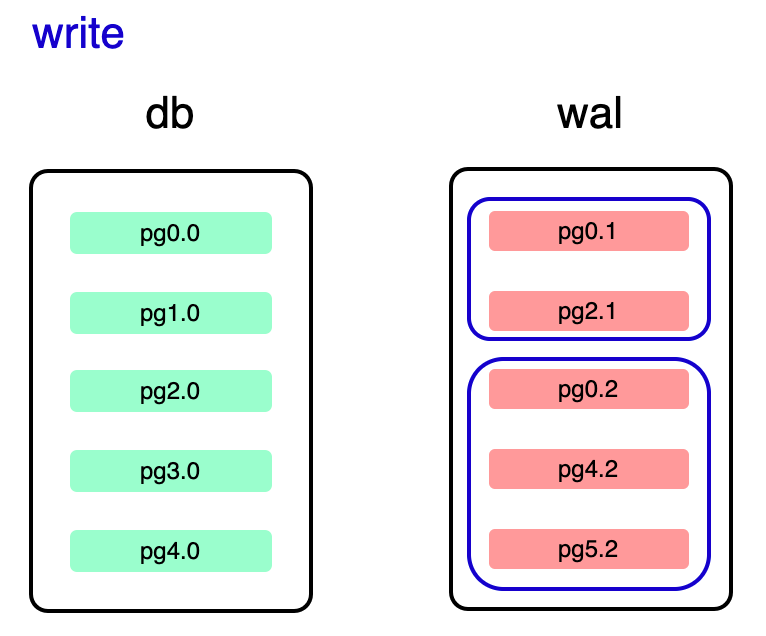
關于寫
- 寫操作總是發生在 wal 文件上;
- 寫操作總是追加在 wal 文件末尾,由 commit 觸發;
- 寫入 wal 文件中是原始 page 修改后的副本;
- 寫操作對 wal 文件的訪問是獨占串行的;
- 事務寫入只有成功落盤(寫入磁盤)才算成功提交,checkpoint 前會調用 wal 文件的 fsync,保證日志提交持久性和一致性;
- 沒有調用 fsync 不代表日志提交一定失敗,會由文件系統定期回寫;
- 如果 fsync 回寫之前發生 crash 或系統崩潰,導致事務 2 的 pg4.2 寫 wal 失敗,可校驗出事務 2 不完整,則 wal 中成功提交的事務只有事務 1; 如果 pg0.1 回寫失敗,則 wal 中沒有成功提交的事務。?
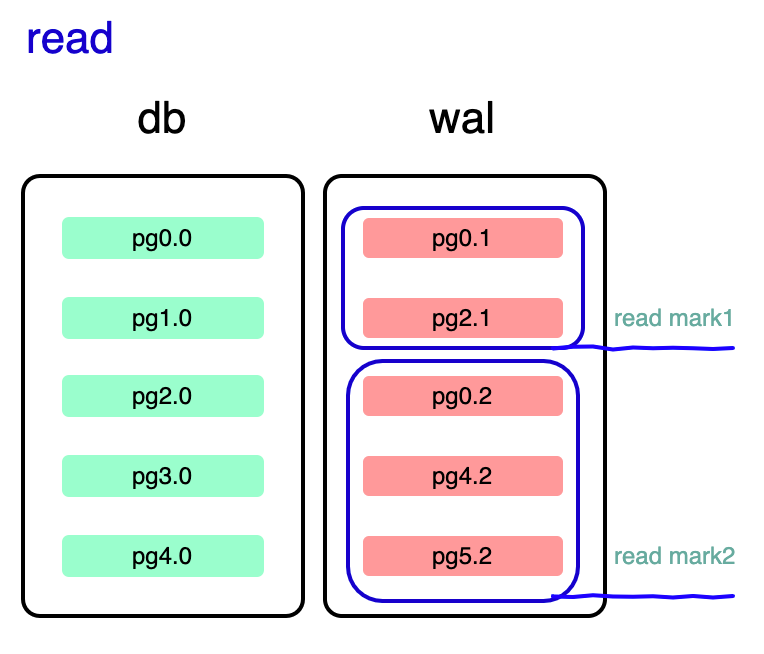
關于讀
- 讀與寫可以并發;
- 每個讀事務會記錄 wal 文件中一個 record 點,作為它的 read mark,每個事務執行過程中 read mark 不會發生改變,新提交的事務產生的修改不會影響舊的事務。read mark 會選擇事務完整提交后的位置。原始 db 文件和 wal 中 read mark 之前的記錄構成了數據庫的一個固定的版本記錄;
- 讀事務讀一個 page 優先讀 wal 文件,沒有則讀原始文件;
- 如果一個 page 在 wal 中有多個副本,讀 read mark 前的最后一個;
- 同一個 read mark 可以被多個讀事務使用。
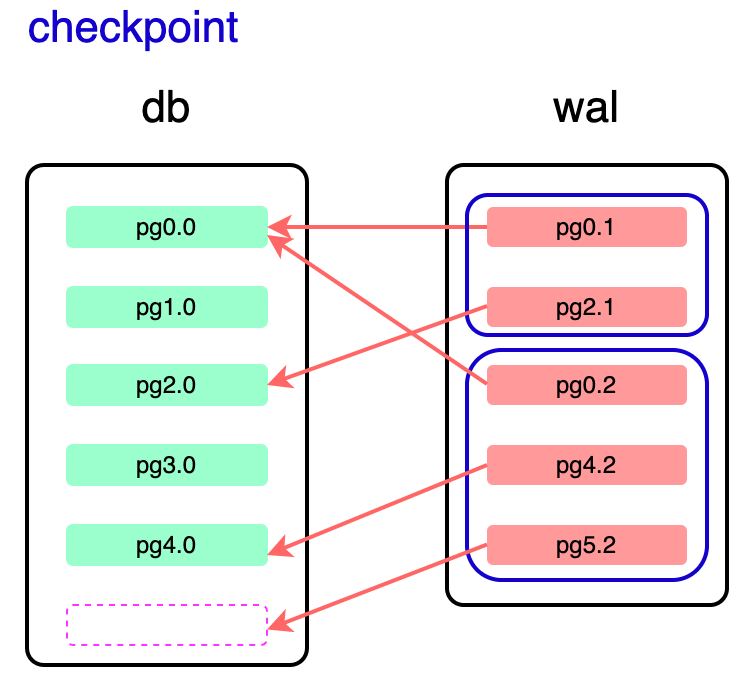
關于 checkpoint:
- checkpoint 針對 wal 中已經成功落盤的事務,每次 checkpoint 前會執行 fsync;
- 每次 checkpoint 從前到后按序回寫 wal 文件中尚未提交的事務到 db;
- 如果 checkpoint 中途 crash,由于事務已持久化到 wal 文件,下次啟動重新按序回寫 wal 中的事務即可;
- wal 中所有的事務 checkpoint 后,wal 文件會從頭開始使用;
- checkpoint 并不一定都會提交 wal 中全部的事務,如果只是部分提交,下次寫入還是會寫入 wal 文件的末尾,wal 文件可能會變很大;
- 只有 truncate 的 checkpoint 才能清理已經異常變大的 wal 文件,會 truncate 文件大小到 0。
二. wal 實現?
wal 的實現大部分代碼集中在 wal.c 中,從 sqlite 的架構劃分應該主要算是 pager 層的實現。
https://www.sqlite.org/arch.html。wal 實現從邏輯上由 3 部分組成:
2.1 wal 和 wal-index 文件格式
文件格式定義,官方文檔見:
??https://www.sqlite.org/walformat.html??
??https://www.sqlite.org/fileformat2.html??
這一層細節比較多,主要是些二進制定義。核心是 wal 格式提供了一種 page 格式的 redo log 組織格式,保證 crash 后 recover 過程滿足一致性。
wal-index 文件(db-shm)只是一種對 wal 文件的快速索引,后文為了省事,也統稱 wal 文件。
2.2 文件多副本抽象
即 wal 和 db 文件對外表現為一個統一的文件抽象,并提供文件級別的 mvcc,對 pager 層屏蔽 wal 細節。
由于 wal 和 db 一樣都是以 pgno 的方式索引 page,按 pgno 替換就可以構造出不同版本的 b 樹,比較簡單。mvcc 主要通過 read lock 的 read mark 實現,前面有介紹過, 后面并發控制部分會詳細舉例介紹。
具體實現可看:
寫入:https://github.com/sqlite/sqlite/blob/version-3.15.2/src/pager.c#L3077
讀取:https://github.com/sqlite/sqlite/blob/version-3.15.2/src/wal.c#L2593
2.3 并發控制
通過文件鎖保證并發操作不會損壞數據庫文件,下一節詳細講解。
三. wal 下的并發
wal 支持讀讀、讀寫的并發,相比最初的 rollback journal 模式提供了更大的并發力度。但 wal 實現的是文件級別的并發,沒有 mysql 表鎖行鎖的概念,一個 db 文件同時的并發寫事務同時只能存在一個,不支持寫的同時并發。checkpoint 也可能會 block 讀寫。
wal 并發實現上主要通過文件鎖,和文件級別 mvcc 來實現文件級別的讀寫并發。
鎖即下文源碼中的 WAL_CKPT_LOCK,WAL_WRITE_LOCK 和WAL_READ_LOCK,出于簡化問題考慮省略了
WAL_RECOVER_LOCK 等相關性不大的其他鎖的討論。mvcc 即通過文件多副本和 read mark 實現,后文也會詳細介紹。
3.1 鎖的分類和作用
官方介紹:https://www.sqlite.org/walformat.html
可看 2.3.1節 How the various locks are used
也可看下面簡化分析:
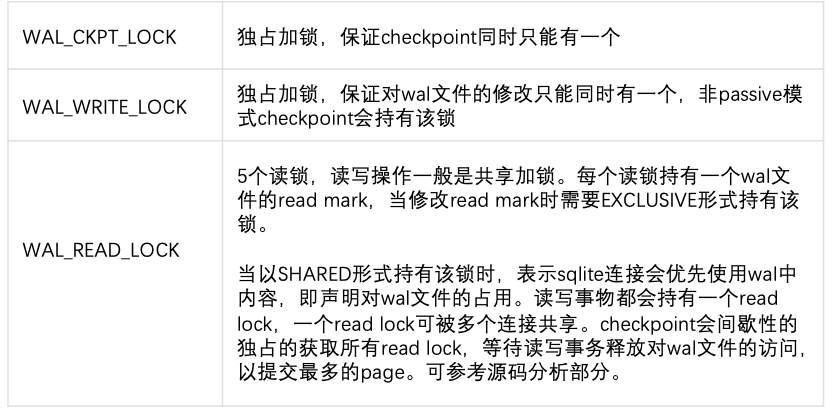
3.2 鎖的持有情況
數據庫的訪問,可以分為 3 類:讀、寫和checkpoint。事務對鎖的持有不總是在事務一開始就持有,后文為了簡化分析,會假設讀寫事務對鎖的持有在事務開始時是已知的,并且與事務同生命周期。實際在讀事務某些執行路徑上也可能會持有 write lock,這里專注主線邏輯。
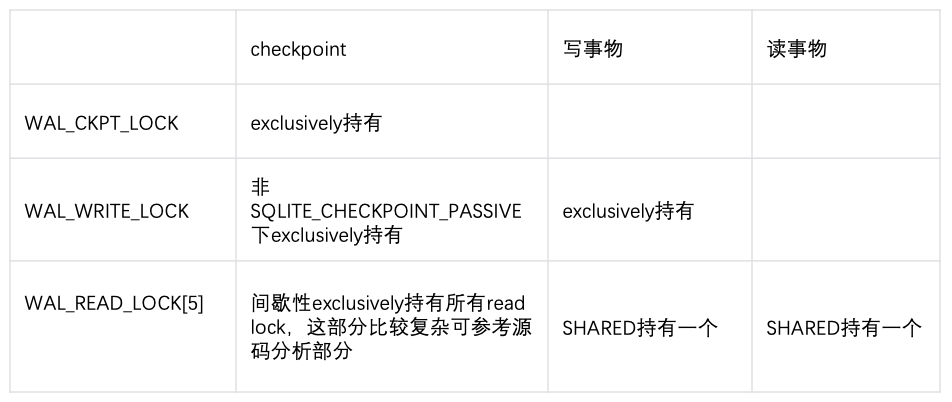
3.3 鎖的應用
這部分可以和源碼分析部分參照起來看,是整個 wal 里面相對復雜的部分,重點,需要來回反復看。
commit transaction:表示已經提交但沒有 checkpoint 的事務,藍框中表示事務修改的頁面。
ongoing transition : 表示正在進行中的事務,同時也表示一個活躍的數據庫連接,藍線表示 read mark 的位置。
pgx.y: 表示 page 的頁號和版本。
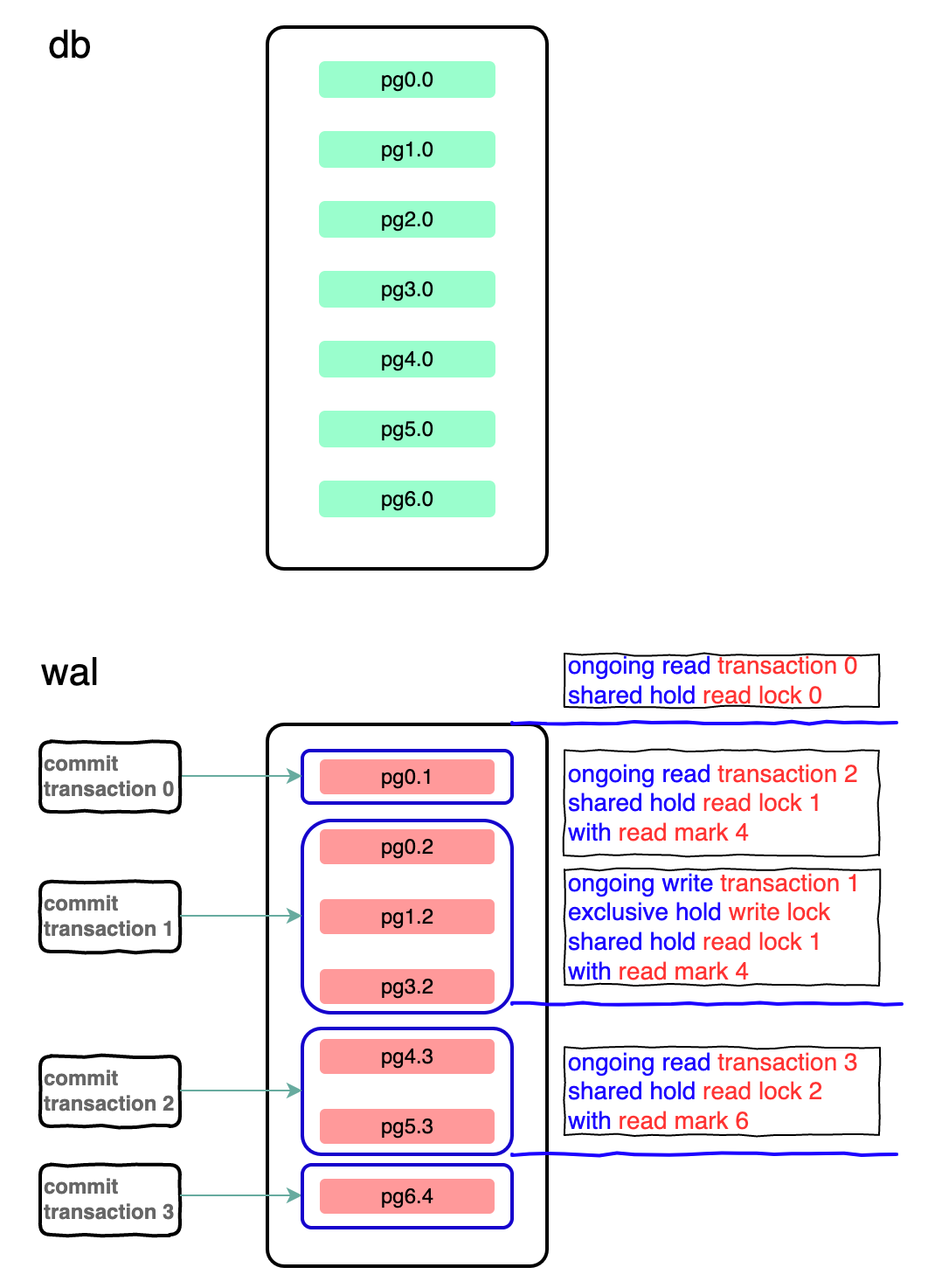
3.3.1 讀寫
如圖可知:
- wal文件存在 4 個已經提交的事務
第一個事務修改了 page0,第二個事務修改了 page0、1、3,依此類推。 - 當前數據庫上存在 4 個活躍的連接,包括 3 個讀事務和 1 個寫事務;
- 寫事務獨占了 WAL_WRITE_LOCK,所以此時不能再發起一個寫事務;
- 寫事務占有 1(4)讀鎖,所以寫事務讀取不到 read mark 4 之后的修改,只能讀取 read mark 4 之前的修改。即寫事務讀取 page4 時不能讀取到 page4.3,只能讀取 page4.0;
- 3 個讀事務占有 0(0),1(4),2(5)三個讀鎖,read mark 只能在事務結束的位置,不會處于中間 page 的位置;
- 后續如果發起一個讀事務,會占有讀鎖 3(7)。理論上可以發起任意多個讀請求,讀鎖可以被 sqlite 連接共享。
3.3.2 checkpoint
這部分要和源碼分析結合,如果此時發起 checkpoint。
- 由于事務 0 持有 read lock 0,read mark 0,計算 mxSafeFrame 為 0,不會發生 checkpoint。
如果事務 0 結束后發起 checkpoint。 - 由于寫事務存在,不能發起非 passive 的 checkpoint。
如果事務 1 結束后執行 checkpoint。 - 計算 mxSafeFrame 等于 4,會提交前 4 個 page,沒有完全提交,wal 文件不會重新利用,新的寫入還是會寫入 commit transaction3 之后。
如果所有事務結束后執行 checkpoint。 - 提交所有頁面,下次寫入 wal 文件頭部。
四. checkpoint 源碼分析
源碼對應 sqlite 3.15.2,通過直接調用 checkpoint 觀察整個過程。
??https://github.com/sqlite/sqlite/tree/version-3.15.2/src??
4.1 調用鏈路
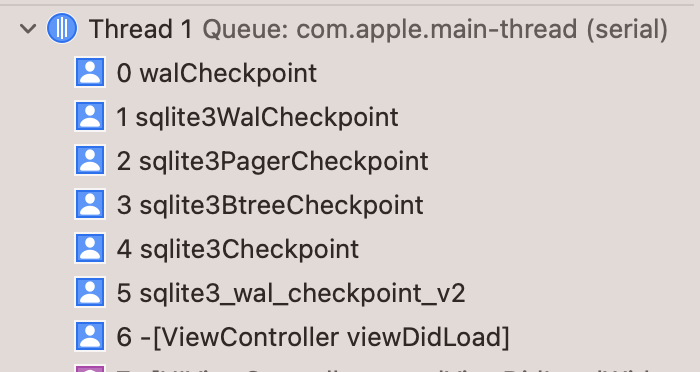
4.2 sqlite3_wal_checkpoint_v2
??https://github.com/sqlite/sqlite/blob/version-3.15.2/src/main.c#L2065??
主要是加鎖和一些參數校驗。
4.3 sqlite3Checkpoint
??https://github.com/sqlite/sqlite/blob/version-3.15.2/src/main.c#L2146??
ndb 上循環 checkpoint,大多數時候只有一個 db 文件。
4.4 sqlite3BtreeCheckpoint
??https://github.com/sqlite/sqlite/blob/version-3.15.2/src/btree.c#L9472??
檢查 btree 是否 locked,也是前置檢查邏輯。
4.5 sqlite3PagerCheckpoint
??https://github.com/sqlite/sqlite/blob/version-3.15.2/src/pager.c#L7198??
也是前置的處理邏輯。不過有個和 checkpoint 邏輯有關的。
/* 只在非SQLITE_CHECKPOINT_PASSIVE模式時設置xBusyHandler
* 即SQLITE_CHECKPOINT_PASSIVE時如果獲取不到鎖,立即返回,不進行等待并retry
*/
if( pPager->pWal ){
rc = sqlite3WalCheckpoint(pPager->pWal, db, eMode,
(eMode==SQLITE_CHECKPOINT_PASSIVE ? 0 : pPager->xBusyHandler),
pPager->pBusyHandlerArg,
pPager->walSyncFlags, pPager->pageSize, (u8 *)pPager->pTmpSpace,
pnLog, pnCkpt
);
}
4.6 sqlite3WalCheckpoint
??https://github.com/sqlite/sqlite/blob/version-3.15.2/src/wal.c#L3192??
int sqlite3WalCheckpoint(
Wal *pWal, /* Wal connection */
int eMode, /* PASSIVE, FULL, RESTART, or TRUNCATE */
int (*xBusy)(void*), /* Function to call when busy */
void *pBusyArg, /* Context argument for xBusyHandler */
int sync_flags, /* Flags to sync db file with (or 0) */
int nBuf, /* Size of temporary buffer */
u8 *zBuf, /* Temporary buffer to use */
int *pnLog, /* OUT: Number of frames in WAL */
int *pnCkpt /* OUT: Number of backfilled frames in WAL */
){
int rc; /* Return code */
int isChanged = 0; /* True if a new wal-index header is loaded */
int eMode2 = eMode; /* Mode to pass to walCheckpoint() */
int (*xBusy2)(void*) = xBusy; /* Busy handler for eMode2 */
assert( pWal->ckptLock==0 );
assert( pWal->writeLock==0 );
/* EVIDENCE-OF: R-62920-47450 The busy-handler callback is never invoked
** in the SQLITE_CHECKPOINT_PASSIVE mode. */
assert( eMode!=SQLITE_CHECKPOINT_PASSIVE || xBusy==0 );
if( pWal->readOnly ) return SQLITE_READONLY;
WALTRACE(("WAL%p: checkpoint begins\n", pWal));
/* IMPLEMENTATION-OF: R-62028-47212 All calls obtain an exclusive
** "checkpoint" lock on the database file. */
// 獨占獲取WAL_CKPT_LOCK鎖
rc = walLockExclusive(pWal, WAL_CKPT_LOCK, 1);
if( rc ){
/* EVIDENCE-OF: R-10421-19736 If any other process is running a
** checkpoint operation at the same time, the lock cannot be obtained and
** SQLITE_BUSY is returned.
** EVIDENCE-OF: R-53820-33897 Even if there is a busy-handler configured,
** it will not be invoked in this case.
*/
testcase( rc==SQLITE_BUSY );
testcase( xBusy!=0 );
return rc;
}
pWal->ckptLock = 1;
/* IMPLEMENTATION-OF: R-59782-36818 The SQLITE_CHECKPOINT_FULL, RESTART and
** TRUNCATE modes also obtain the exclusive "writer" lock on the database
** file.
**
** EVIDENCE-OF: R-60642-04082 If the writer lock cannot be obtained
** immediately, and a busy-handler is configured, it is invoked and the
** writer lock retried until either the busy-handler returns 0 or the
** lock is successfully obtained.
*/
// 非SQLITE_CHECKPOINT_PASSIVE時,獨占獲取WAL_WRITE_LOCK鎖,并進行busy retry
if( eMode!=SQLITE_CHECKPOINT_PASSIVE ){
rc = walBusyLock(pWal, xBusy, pBusyArg, WAL_WRITE_LOCK, 1);
if( rc==SQLITE_OK ){
pWal->writeLock = 1;
}else if( rc==SQLITE_BUSY ){
eMode2 = SQLITE_CHECKPOINT_PASSIVE;
xBusy2 = 0;
rc = SQLITE_OK;
}
}
//如果wal-index顯示db有變化,unfetch db文件,和主線邏輯關系不大
/* Read the wal-index header. */
if( rc==SQLITE_OK ){
rc = walIndexReadHdr(pWal, &isChanged);
if( isChanged && pWal->pDbFd->pMethods->iVersion>=3 ){
sqlite3OsUnfetch(pWal->pDbFd, 0, 0);
}
}
/* Copy data from the log to the database file. */
if( rc==SQLITE_OK ){
if( pWal->hdr.mxFrame && walPagesize(pWal)!=nBuf ){
rc = SQLITE_CORRUPT_BKPT;
}else{
// checkpoint
rc = walCheckpoint(pWal, eMode2, xBusy2, pBusyArg, sync_flags, zBuf);
}
/* If no error occurred, set the output variables. */
if( rc==SQLITE_OK || rc==SQLITE_BUSY ){
if( pnLog ) *pnLog = (int)pWal->hdr.mxFrame;
if( pnCkpt ) *pnCkpt = (int)(walCkptInfo(pWal)->nBackfill);
}
}
// release wal index,非主線邏輯
if( isChanged ){
/* If a new wal-index header was loaded before the checkpoint was
** performed, then the pager-cache associated with pWal is now
** out of date. So zero the cached wal-index header to ensure that
** next time the pager opens a snapshot on this database it knows that
** the cache needs to be reset.
*/
memset(&pWal->hdr, 0, sizeof(WalIndexHdr));
}
// 釋放鎖,返回
/* Release the locks. */
sqlite3WalEndWriteTransaction(pWal);
walUnlockExclusive(pWal, WAL_CKPT_LOCK, 1);
pWal->ckptLock = 0;
WALTRACE(("WAL%p: checkpoint %s\n", pWal, rc ? "failed" : "ok"));
return (rc==SQLITE_OK && eMode!=eMode2 ? SQLITE_BUSY : rc);
}
4.7 walCheckpoint
??https://github.com/sqlite/sqlite/blob/version-3.15.2/src/wal.c#L1724??
static int walCheckpoint(
Wal *pWal, /* Wal connection */
int eMode, /* One of PASSIVE, FULL or RESTART */
int (*xBusy)(void*), /* Function to call when busy */
void *pBusyArg, /* Context argument for xBusyHandler */
int sync_flags, /* Flags for OsSync() (or 0) */
u8 *zBuf /* Temporary buffer to use */
){
int rc = SQLITE_OK; /* Return code */
int szPage; /* Database page-size */
WalIterator *pIter = 0; /* Wal iterator context */
u32 iDbpage = 0; /* Next database page to write */
u32 iFrame = 0; /* Wal frame containing data for iDbpage */
u32 mxSafeFrame; /* Max frame that can be backfilled */
u32 mxPage; /* Max database page to write */
int i; /* Loop counter */
volatile WalCkptInfo *pInfo; /* The checkpoint status information */
szPage = walPagesize(pWal);
testcase( szPage<=32768 );
testcase( szPage>=65536 );
pInfo = walCkptInfo(pWal);
if( pInfo->nBackfill<pWal->hdr.mxFrame ){
/* Allocate the iterator */
rc = walIteratorInit(pWal, &pIter);
if( rc!=SQLITE_OK ){
return rc;
}
assert( pIter );
/* EVIDENCE-OF: R-62920-47450 The busy-handler callback is never invoked
** in the SQLITE_CHECKPOINT_PASSIVE mode. */
assert( eMode!=SQLITE_CHECKPOINT_PASSIVE || xBusy==0 );
/* Compute in mxSafeFrame the index of the last frame of the WAL that is
** safe to write into the database. Frames beyond mxSafeFrame might
** overwrite database pages that are in use by active readers and thus
** cannot be backfilled from the WAL.
*/
mxSafeFrame = pWal->hdr.mxFrame;
mxPage = pWal->hdr.nPage;
/* 計算mxSafeFrame
* 會嘗試獨占的獲取aReadMark鎖,如果獲取到,則代表原先持有對應aReadMark鎖的事務已經結束。
* 會不斷的用busy rerty邏輯等待對應的讀鎖釋放。
* 如果對應事物一直沒有釋放aReadMark鎖,最終的 mxSafeFrame = MIN(unfinished_aReadMarks)
*/
for(i=1; i<WAL_NREADER; i++){
/* Thread-sanitizer reports that the following is an unsafe read,
** as some other thread may be in the process of updating the value
** of the aReadMark[] slot. The assumption here is that if that is
** happening, the other client may only be increasing the value,
** not decreasing it. So assuming either that either the "old" or
** "new" version of the value is read, and not some arbitrary value
** that would never be written by a real client, things are still
** safe. */
u32 y = pInfo->aReadMark[i];
if( mxSafeFrame>y ){
assert( y<=pWal->hdr.mxFrame );
// 嘗試獲取 WAL_READ_LOCK(i)鎖,并進行忙等待
rc = walBusyLock(pWal, xBusy, pBusyArg, WAL_READ_LOCK(i), 1);
if( rc==SQLITE_OK ){
// 成功獲取 WAL_READ_LOCK(i)鎖,設置為READMARK_NOT_USED;i==1,是個treak,不影響主流程
pInfo->aReadMark[i] = (i==1 ? mxSafeFrame : READMARK_NOT_USED);
walUnlockExclusive(pWal, WAL_READ_LOCK(i), 1);
}else if( rc==SQLITE_BUSY ){
// 一直沒有獲取對應WAL_READ_LOCK(i)鎖,設置mxSafeFrame為y
mxSafeFrame = y;
xBusy = 0;
}else{
goto walcheckpoint_out;
}
}
}
// 開始從wal文件寫回db文件,此時獨占的持有WAL_READ_LOCK(0)
if( pInfo->nBackfill<mxSafeFrame
&& (rc = walBusyLock(pWal, xBusy, pBusyArg, WAL_READ_LOCK(0),1))==SQLITE_OK
){
i64 nSize; /* Current size of database file */
u32 nBackfill = pInfo->nBackfill;
pInfo->nBackfillAttempted = mxSafeFrame;
/* Sync the WAL to disk */
if( sync_flags ){
rc = sqlite3OsSync(pWal->pWalFd, sync_flags);
}
/* If the database may grow as a result of this checkpoint, hint
** about the eventual size of the db file to the VFS layer.
*/
if( rc==SQLITE_OK ){
i64 nReq = ((i64)mxPage * szPage);
rc = sqlite3OsFileSize(pWal->pDbFd, &nSize);
if( rc==SQLITE_OK && nSize<nReq ){
sqlite3OsFileControlHint(pWal->pDbFd, SQLITE_FCNTL_SIZE_HINT, &nReq);
}
}
// 邏輯比較簡單,遍歷并回寫
/* Iterate through the contents of the WAL, copying data to the db file */
while( rc==SQLITE_OK && 0==walIteratorNext(pIter, &iDbpage, &iFrame) ){
i64 iOffset;
assert( walFramePgno(pWal, iFrame)==iDbpage );
if( iFrame<=nBackfill || iFrame>mxSafeFrame || iDbpage>mxPage ){
continue;
}
iOffset = walFrameOffset(iFrame, szPage) + WAL_FRAME_HDRSIZE;
/* testcase( IS_BIG_INT(iOffset) ); // requires a 4GiB WAL file */
rc = sqlite3OsRead(pWal->pWalFd, zBuf, szPage, iOffset);
if( rc!=SQLITE_OK ) break;
iOffset = (iDbpage-1)*(i64)szPage;
testcase( IS_BIG_INT(iOffset) );
rc = sqlite3OsWrite(pWal->pDbFd, zBuf, szPage, iOffset);
if( rc!=SQLITE_OK ) break;
}
/* If work was actually accomplished... */
if( rc==SQLITE_OK ){
if( mxSafeFrame==walIndexHdr(pWal)->mxFrame ){
i64 szDb = pWal->hdr.nPage*(i64)szPage;
testcase( IS_BIG_INT(szDb) );
rc = sqlite3OsTruncate(pWal->pDbFd, szDb);
if( rc==SQLITE_OK && sync_flags ){
rc = sqlite3OsSync(pWal->pDbFd, sync_flags);
}
}
if( rc==SQLITE_OK ){
/* 更新nBackfill為已經checkpoint的部分
* nBackfill記錄當前已經checkpoint的部分
*/
pInfo->nBackfill = mxSafeFrame;
}
}
/* Release the reader lock held while backfilling */
// 釋放 WAL_READ_LOCK(0)
walUnlockExclusive(pWal, WAL_READ_LOCK(0), 1);
}
if( rc==SQLITE_BUSY ){
/* Reset the return code so as not to report a checkpoint failure
** just because there are active readers. */
rc = SQLITE_OK;
}
}
/* If this is an SQLITE_CHECKPOINT_RESTART or TRUNCATE operation, and the
** entire wal file has been copied into the database file, then block
** until all readers have finished using the wal file. This ensures that
** the next process to write to the database restarts the wal file.
*/
// 非passive的checkpoint的區別都在這里
if( rc==SQLITE_OK && eMode!=SQLITE_CHECKPOINT_PASSIVE ){
assert( pWal->writeLock );
if( pInfo->nBackfill<pWal->hdr.mxFrame ){
// 沒有全部checkpoint
rc = SQLITE_BUSY;
}else if( eMode>=SQLITE_CHECKPOINT_RESTART ){
// RESTART or TRUNCATE
u32 salt1;
sqlite3_randomness(4, &salt1);
assert( pInfo->nBackfill==pWal->hdr.mxFrame );
// 獲取所有讀鎖, 保證下一個事物能夠重新開始restart,即循環利用wal文件
rc = walBusyLock(pWal, xBusy, pBusyArg, WAL_READ_LOCK(1), WAL_NREADER-1);
if( rc==SQLITE_OK ){
if( eMode==SQLITE_CHECKPOINT_TRUNCATE ){
/* IMPLEMENTATION-OF: R-44699-57140 This mode works the same way as
** SQLITE_CHECKPOINT_RESTART with the addition that it also
** truncates the log file to zero bytes just prior to a
** successful return.
**
** In theory, it might be safe to do this without updating the
** wal-index header in shared memory, as all subsequent reader or
** writer clients should see that the entire log file has been
** checkpointed and behave accordingly. This seems unsafe though,
** as it would leave the system in a state where the contents of
** the wal-index header do not match the contents of the
** file-system. To avoid this, update the wal-index header to
** indicate that the log file contains zero valid frames. */
walRestartHdr(pWal, salt1);
// Truncate wal文件
rc = sqlite3OsTruncate(pWal->pWalFd, 0);
}
walUnlockExclusive(pWal, WAL_READ_LOCK(1), WAL_NREADER-1);
}
}
}
walcheckpoint_out:
walIteratorFree(pIter);
return rc;
}
五. 常見問題
5.1 checkpoint 何時觸發
- 手動調用 checkpoint 觸發;
- 通過 sql 語句 PRAGMA wal_checkpoint 觸發;
- sqlite 官方默認的 checkpoint 閾值是 1000 page,即當 wal 文件達到 1000 page 大小時,寫操作的線程在完成寫操作后同步進行 checkpoint 操作;
- 當最后一個連接 close 時觸發。
5.2 checkpoint 四種 mode 的區別
- passive 不會加寫鎖,也就是不會 block 寫操作;
- 其他三種
mode 在回寫 db 結束之前的邏輯都是一樣。區別是 restart 會嘗試再次獨占獲取讀鎖,保證 restart 型的
checkpoint 正常結束后,下一個發起的事務會從頭開始循環利用 wal 文件。truncate 模式更近一步會 truncate wal
文件。
5.3 wal 下讀寫和 checkpoint 的并發性
可看看上面不同操作對鎖的持有情況:
- 讀和讀可以同時進行;
- 讀和寫可以同時進行;
- checkpoint 和讀事務也存在很大程度的并發,checkpoint 對讀鎖持有都是間歇性的,理論上都是耗時很短。仔細觀察上面的源碼分析部分,雖然會周期性持有讀鎖,基本上是等待讀事務釋放讀鎖,在真正耗時的 io 操作回寫 wal 日志到 db 的過程中,還是可以發起讀事務的。這種實現 checkpoint 對讀存在著某種避讓,讀操作過于激進,會導致 checkpoint 饑餓,極端點會導致 wal 文件異常大;
- passive checkpoint 和寫事務,理論上也是可以并發;
- 非passive checkpoint 和寫事務,理論上不可以并發。
5.4 wal 文件巨大的原因 & 如何解決
5.4.1 原因
wal 文件提供的操作模型非常簡單,只有在一次完整的
checkpoint 后才會重頭開始循環利用 wal 文件,如果 checkpoint 一直沒有提交當前的 wal 文件中所有更新,會導致
wal 文件無限增大。同時只有在 truncate 模式 checkpoint 才會縮減 wal 文件。
大概有以下原因會導致 wal 不能完全提交,核心都是 checkpoint 競爭不到鎖。
- 非 passive 模式 checkpoint,需要獲取 write lock,但獲取不到;
- passive 模式 checkpoint 過程中,有并發的寫操作,導致 wal 中有未提交的日志;
- checkpoint 沒能及時獲取所以讀鎖。
在 checkpoint 中不能如預料中的獲得鎖,主要有兩種可能:
- 事務耗時很長,導致鎖遲遲不能釋放;
- 數據連接中存在鎖丟失的情況,導致 checkpoint 永遠不能獲取到需求的鎖;
- 數據庫連接過多,導致 checkpoint 過程中競爭不到鎖。
5.4.2 解決方案
綜上要解決 wal 無限增大主要有:
- 盡量把無關代碼移除事務,保證事務只做數據庫相關的操作;
- 檢查代碼,避免出現鎖丟失的情況;
- 讀寫操作適當退避,保證 checkpoint 有機會完全提交,而不總是部分提交。





































